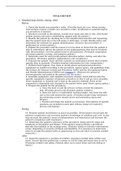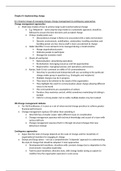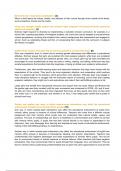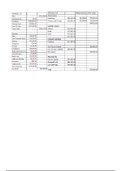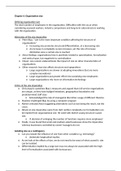lOMoARcPSD|18428872
Chapter 1-4 Econ Midterm
Economics (The University of Western Ontario)
Studocu is not sponsored or endorsed by any college or university
Downloaded by Samar Mutreja ()
, lOMoARcPSD|18428872
Chapter 1:
What is Economics?
● All economic questions arise because we want more than we can get (scarcity).
● Scarcity: our inability to satisfy all our wants
● Choices: Because of scarcity, we must make choices
● The choices we make depend on the incentives we face
● An incentive is a reward that encourages an action or a penalty that discourages an
action
○ Prices act as incentives. If the price of a laptop is too high, more will be offered
for sale than people want. If the price of a laptop is too low, fewer will be offered
for sale than people want to buy.
Example Question: The problem of scarcity applies
A) Only in industrially developed countries because resource are scarce in these countries
B) Only in countries that are overpopulated
C) Only in countries that use natural resources in most of their production processes
D) To all countries, regardless of their level of development
● Economics is the social science that studies the choices that individuals, businesses,
governments, and entire societies make as they cope with scarcity and the incentives
that influence and reconcile those choices
○ Economics divided into: Microeconomics and Macroeconomics
● Microeconomics is the study of choices that individuals and businesses make, the way
these choices interact in markets, and the influence of governments
○ An example of a microeconomic question is: Why are people buying more
ebooks and fewer hard copy books?
● Macroeconomics is the study of performance of the national and global economies
○ An example of a macroeconomic question is: Why does the unemployment rate
in Canada fluctuate?
Example Question: Which of the following are microeconomic topics? (More than one answer)
A) The reasons why a consumer buys less honey
B) The reasons why the average price level in a country falls
C) The cause of increasing unemployment
D) The effect of the government budget deficit on inflation
E) When the price of gas increases, consumer consumes less gas
Two Big Economic Questions
Downloaded by Samar Mutreja ()
, lOMoARcPSD|18428872
Two big questions summarize the scope of economics:
● How do choices end up determining what, how, and for whom goods and services get
produced?
○ What, How and For Whom?
■ Goods and services are the objects that people value and produce to
satisfy human wants
■ Goods are physical objects such as automobiles and phones
■ Services are tasks performed for people such as repairs
○ What?
■ What we produce varies across countries and changes
■ What determines these patterns of production?
■ How do choices end up determining the quantities of smartphones,
automobiles and other items produced in Canada?
■ In Canada, agriculture accounts for 2% of total production, manufactured
goods for 28%, and services (retail, wholesale, healthcare, education) for
70%.
○ How?
■ How we produce is described by the technologies and resources that we
use.
■ Goods and services are produced by using productive resources that
economists call factors of production; factors of production can be
grouped into four categories:
● Land
● Labor
● Capital
● Entreupenurship
■ The “gifts of nature” that we use to produce goods and services are land
■ The work time and work effort that people devote to producing goods and
services is labor
● The quality of labor depends on human capital, which is the
knowledge and skill that people obtain from education
■ The tools, instruments, machines, buildings, and other constructions that
businesses use to produce goods and services are called capital
● Financial capital is money, stocks, and bonds
■ The human resource that organizes land, labor, and capital is called
entrepreneurship
○ For Whom?
■ Who gets the goods and services depends on the incomes that people
earn
■ Land earns rent
■ Labor earns wages
■ Capital earns interest
■ Entrepreneurship earns profit
Downloaded by Samar Mutreja ()
, lOMoARcPSD|18428872
● When do choices made in the pursuit of self-interest also promote the social interest?
○ Self-Interest
■ You make choices that are in your self-interest—choices that you think
are best for you
■ You may take into account how your choices affect other people, but it is
how you feel that influences your choice
○ Social Interest
■ Choices that are best for society as a whole are said to be in the social
interest
■ Social interest has two dimensions:
● Efficiency
● Equity
■ Use Ted as an example. Ted creates a business in his self-interest
because he gains a million dollars per week. But he pays his employees
more than their previous jobs which is in their self-interest also. This is
considered social-interest because it makes everyone better off.
○ Efficiency and Social Interest
■ Resource use is efficient if it is not possible to make someone better off
without making someone else worse off
■ Equity is fairness, but economists have a variety of views about what is
fair
○ Fair Shares and Social Interest
■ The idea that the social interest requires faire shares is a deeply held one
■ But what is fair?
■ Four topics that generate discussion that illustrate tension between
self-interest and social interest are
● Globalization
● Information-age monopolies
● Global warming
● Economic instability
○ Globalization
■ Globalization means the expansion of international trade, borrowing and
lending, and investment
■ Globalization is in the self interest of consumers who buy low-cost
imported goods and services and …
■ … in the self interest of the multinational firms that produce in low-cost
regions and sell in high-price regions
■ But is globalization in the self-interest of low-wage workers in other
countries and Canadian firms that can’t compete with low-cost imports?
■ Is globalization in the social interest?
○ Information-Age Monopolies
■ The technological change of the past forty years has been called the
Information Revolution
Downloaded by Samar Mutreja ()
Chapter 1-4 Econ Midterm
Economics (The University of Western Ontario)
Studocu is not sponsored or endorsed by any college or university
Downloaded by Samar Mutreja ()
, lOMoARcPSD|18428872
Chapter 1:
What is Economics?
● All economic questions arise because we want more than we can get (scarcity).
● Scarcity: our inability to satisfy all our wants
● Choices: Because of scarcity, we must make choices
● The choices we make depend on the incentives we face
● An incentive is a reward that encourages an action or a penalty that discourages an
action
○ Prices act as incentives. If the price of a laptop is too high, more will be offered
for sale than people want. If the price of a laptop is too low, fewer will be offered
for sale than people want to buy.
Example Question: The problem of scarcity applies
A) Only in industrially developed countries because resource are scarce in these countries
B) Only in countries that are overpopulated
C) Only in countries that use natural resources in most of their production processes
D) To all countries, regardless of their level of development
● Economics is the social science that studies the choices that individuals, businesses,
governments, and entire societies make as they cope with scarcity and the incentives
that influence and reconcile those choices
○ Economics divided into: Microeconomics and Macroeconomics
● Microeconomics is the study of choices that individuals and businesses make, the way
these choices interact in markets, and the influence of governments
○ An example of a microeconomic question is: Why are people buying more
ebooks and fewer hard copy books?
● Macroeconomics is the study of performance of the national and global economies
○ An example of a macroeconomic question is: Why does the unemployment rate
in Canada fluctuate?
Example Question: Which of the following are microeconomic topics? (More than one answer)
A) The reasons why a consumer buys less honey
B) The reasons why the average price level in a country falls
C) The cause of increasing unemployment
D) The effect of the government budget deficit on inflation
E) When the price of gas increases, consumer consumes less gas
Two Big Economic Questions
Downloaded by Samar Mutreja ()
, lOMoARcPSD|18428872
Two big questions summarize the scope of economics:
● How do choices end up determining what, how, and for whom goods and services get
produced?
○ What, How and For Whom?
■ Goods and services are the objects that people value and produce to
satisfy human wants
■ Goods are physical objects such as automobiles and phones
■ Services are tasks performed for people such as repairs
○ What?
■ What we produce varies across countries and changes
■ What determines these patterns of production?
■ How do choices end up determining the quantities of smartphones,
automobiles and other items produced in Canada?
■ In Canada, agriculture accounts for 2% of total production, manufactured
goods for 28%, and services (retail, wholesale, healthcare, education) for
70%.
○ How?
■ How we produce is described by the technologies and resources that we
use.
■ Goods and services are produced by using productive resources that
economists call factors of production; factors of production can be
grouped into four categories:
● Land
● Labor
● Capital
● Entreupenurship
■ The “gifts of nature” that we use to produce goods and services are land
■ The work time and work effort that people devote to producing goods and
services is labor
● The quality of labor depends on human capital, which is the
knowledge and skill that people obtain from education
■ The tools, instruments, machines, buildings, and other constructions that
businesses use to produce goods and services are called capital
● Financial capital is money, stocks, and bonds
■ The human resource that organizes land, labor, and capital is called
entrepreneurship
○ For Whom?
■ Who gets the goods and services depends on the incomes that people
earn
■ Land earns rent
■ Labor earns wages
■ Capital earns interest
■ Entrepreneurship earns profit
Downloaded by Samar Mutreja ()
, lOMoARcPSD|18428872
● When do choices made in the pursuit of self-interest also promote the social interest?
○ Self-Interest
■ You make choices that are in your self-interest—choices that you think
are best for you
■ You may take into account how your choices affect other people, but it is
how you feel that influences your choice
○ Social Interest
■ Choices that are best for society as a whole are said to be in the social
interest
■ Social interest has two dimensions:
● Efficiency
● Equity
■ Use Ted as an example. Ted creates a business in his self-interest
because he gains a million dollars per week. But he pays his employees
more than their previous jobs which is in their self-interest also. This is
considered social-interest because it makes everyone better off.
○ Efficiency and Social Interest
■ Resource use is efficient if it is not possible to make someone better off
without making someone else worse off
■ Equity is fairness, but economists have a variety of views about what is
fair
○ Fair Shares and Social Interest
■ The idea that the social interest requires faire shares is a deeply held one
■ But what is fair?
■ Four topics that generate discussion that illustrate tension between
self-interest and social interest are
● Globalization
● Information-age monopolies
● Global warming
● Economic instability
○ Globalization
■ Globalization means the expansion of international trade, borrowing and
lending, and investment
■ Globalization is in the self interest of consumers who buy low-cost
imported goods and services and …
■ … in the self interest of the multinational firms that produce in low-cost
regions and sell in high-price regions
■ But is globalization in the self-interest of low-wage workers in other
countries and Canadian firms that can’t compete with low-cost imports?
■ Is globalization in the social interest?
○ Information-Age Monopolies
■ The technological change of the past forty years has been called the
Information Revolution
Downloaded by Samar Mutreja ()

